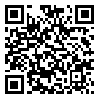Mon, Jun 30, 2025
| فارسی
Volume 20, Issue 1 (Spring 2014)
IJPCP 2014, 20(1): 63-73 |
Back to browse issues page
Download citation:
BibTeX | RIS | EndNote | Medlars | ProCite | Reference Manager | RefWorks
Send citation to:



BibTeX | RIS | EndNote | Medlars | ProCite | Reference Manager | RefWorks
Send citation to:
Zeinali A. Risk and Protective Factors in West Azerbaijan Province Students Addiction Susceptibility. IJPCP 2014; 20 (1) :63-73
URL: http://ijpcp.iums.ac.ir/article-1-2136-en.html
URL: http://ijpcp.iums.ac.ir/article-1-2136-en.html
Department of Psychology, Islamic Azad University, Khoy Branch, Khoy, Iran, IR. , E-mail: zeinali@iaukhoy.ac.ir
Abstract: (11155 Views)
Objectives: The purpose of this study was to investigate the risk and protective factors of youth addiction susceptibility. Method: From target population-associate’s degree and undergraduate male and female students from Islamic Azad University branches in West Azerbaijan province aged 18 to 41 years- 592 students were chosen using cluster random sampling method from Islamic Azad University branches in Uremia, Khoy, Mako, Mahabad and Bokan based on sex, course of study, and academic grade. Data was gathered through Addiction Susceptibility Questionnaire-Student Version (ASQ-SV) and analyzed using one way analysis of variance and path analysis. Results: The addiction susceptibility in male students was more than the females’, single more than the married, higher academic grades more than the lower grades, regular and sporadic users more than non-users of cigarettes, and the same in different educational groups. Mother employment with increasing the students' academic achievement indirectly decreased their addiction susceptibility, but directly was ineffective to the increase and decrease of student academic status and addiction susceptibility. The number of friends did not affect the increase and decrease of academic achievement, but directly and indirectly increased their addiction susceptibility with increasing the unfavorable academic status. Conclusion: The academic achievement, favorable academic status, few friends, nonsmoking and employed mothers were considered as protective factors and being male, single, academic drop, unfavorable academic status, the number of friends, and regular or sporadic smoking as the risk factors for addiction susceptibility.
Type of Study: Original Research |
Subject:
Psychiatry and Psychology
Received: 2014/07/23 | Accepted: 2014/07/23 | Published: 2014/07/23
Received: 2014/07/23 | Accepted: 2014/07/23 | Published: 2014/07/23
| Rights and permissions | |
 |
This work is licensed under a Creative Commons Attribution-NonCommercial 4.0 International License. |



